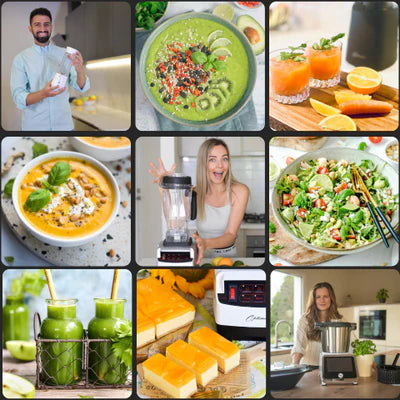What are some juicing tips to make the most from my cold press juicer?
For the most nutritious and best tasting juices, use seasonal fruits and vegetables. It’s not only fresher and healthier, but it will give you more juice. Unlike old centrifugal machines, cold press juicers like the Optimum range don’t require forceful pressing or shoving, instead, let the fruits and vegetables fall naturally through the feeding chute of the juicers to prevent clogging and overflow. To optimize juicing efficiency, alternate between juicer fruits like apples, carrots, cucumber, and more fibrous vegetables like kale, spinach and celery, saving carrots for last to help push out any extra pulp.
How do I make nut milk with my juicer?
While cold press juicers are primarily designed for extracting juices from fruits and vegetables, some models can make nuts milks if they have a blank strainer. If your juicer has a blank strainer, soak one cup of raw nuts overnight in water to soften and activate the enzymes. Rinse thoroughly the next day and add fresh water to the nuts in a bowl, adjust the amount of water for your desired milk consistency. Gradually spoon the nuts and water into the juicer while it’s running with the blank strainer, ensuring a steady pace to prevent clogging. Then drink and enjoy your delicious nut milk!
How does a cold press juicer work?
Cold press juicers, also known as masticating or slow juicers, use a gentle crushing and squeezing mechanism with a rotating auger and strainer to extract juice from fruits and vegetables. Unlike traditional centrifugal juicers, which use a high-speed spinning disc that generates heat during juicing, cold press juicers operate at lower speeds and preserve more nutrients.
What should I look for before buying a juicer?
Before buying a juicer, it’s best to look at all the specs. Consider if the juicer is a centrifugal or cold press, what motor power it has, the feeding chute and hopper size, noise level and ease of cleaning. It’s also worth looking at the juicer design to make sure it fits in with your kitchen.
What fruits and vegetables can I juice?
You can juice a wide variety of fruits and vegetables like apples, carrots, kale, spinach, celery, oranges, lemons, limes, berries, beetroot, ginger and many more. Just make sure to peel all citrus fruits before juicing and you can even experiment with different combinations to create new flavors.
Can you tell me the difference between the Optimum 600XXL, Optimum H3000 2nd Generation and Optimum 600M juicers?
Optimum 600m is a compact cold press juicer with 200 watts of power that can juice a wide range of fruits and vegetables and even includes a blank strainer for ice cream and sorbets. The Optimum 600m is designed for efficient and slow juice extraction in a compact, easy-to-use package.
Optimum H3000 2nd Generation is a horizontal cold press juicer with a powerful 300-watt motor and a larger 7.6 cm feeding chute designed to extract maximum nutrition from both hard and soft fruits and vegetables. It features advanced technology like a vacuum function which seals your juices in a portable bottle preventing oxidization.
Optimum 600XXL is a vertical cold press juicer with 250 watts of power and an extra-large 22.8 cm feeding chute for whole fruits and vegetables. This top-of-the-line cold press juicer makes juicing larger quantities quick and easy while preserving all the essential nutrients.
How do I clean and maintain the juicer?
Cleaning a cold press juicer is quick and easy by washing the parts with warm soapy water and using the included cleaning brush to remove any residue. To maintain the juicer, it’s best to check all the seals are clean and secure before juicing. Always refer to the juicers user manual for specific care instructions.
If I’m not happy with our juicer, can I exchange it or get a refund?
You sure can! If you’re not happy with the juicer for any reason at all, our 30-day money-back guarantee allows you to get a refund or exchange it for another cold press juice machine from our range.
Featured Products










